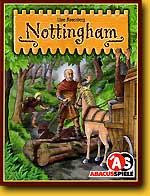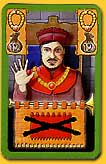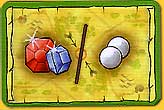Nottingham
Author: Uwe Rosenberg
Publisher: Abacusspiele
Year: 2006
review by

| x |
|
|
|
|
|
|
|
|
|
|
|
|
|
|
|
|
|
|
|
|
|
|
|
|
|
|
|
|
|
|
|
|
|
|
|
|
|
|
|
|
|
 |
No, we are not Robin Hood and his Merry Men in the card game Nottingham. This time we’re approaching the well-known tale from a different perspective: that of the Sheriff of Nottingham. The poor man is having a hard time: his term as Sheriff is drawing to an end, and he doesn’t have enough money yet to buy (!) himself another year. We are his deputies, and we are sent into the Shire to collect the overdue taxes from the poor people of Nottingham. This, you would think, is where Robin Hood comes in! But no, the Prince of Thieves is nowhere to be seen in this game, and the poor people will just have to manage by themselves... The stakes are high: the deputy that collects the largest sum of money will be promoted to Chief Assistant, a very desirable position that would look good on anybodies CV. Our main goal is to rob our competitors from their money, so we can report back to the Sheriff with the largest check! |
| x |
|
|
|
|
|
|
|
|
|
|
|
|
|
|
|
|
|
|
|
|
|
|
|
|
|
|
|
|
|
|
|
|
|
|
|
|
|
|
|
|
|
| In a turn, a player starts with drawing a card from a blind stack. Each card shows one item, and there are seven different cards. The items can be exchanged for money later in the game. Each card also shows an action; the actions are grouped with the items: the card with the candlestick always contains the action ‘steal’. The player can choose to keep the card, or to carry out the action. The actions all involve taking a card from an opponent, but there are seven different ways to rob your colleagues. |
|
|
| x |
|
|
|
|
|
|
|
|
|
|
|
|
|
|
|
|
|
|
|
|
|
|
|
|
|
|
|
|
|
|
|
|
|
|
|
|
|
|
|
|
|
|
|
|
1. Steal/candlestick: draw a card from a player of your choice, and give this player the candlestick as compensation.
2. Rob/pearls: look at the cards of a player of you choice, choose one and give this player the pearls.
3. Hold-up/jewels: a player of your choice puts his cards open on the table, clearly visible for all players. Choose one, and give the player the jewels.
4. Purchase/copper coin: all players offer one card. The active player chooses one, and gives the former owner the copper coin.
|
| x |
|
|
|
|
|
|
|
|
|
|
|
|
|
|
|
|
|
|
|
|
|
|
|
|
|
|
|
|
|
|
|
|
|
|
|
|
|
|
|
|
|
|
5. Trade/chest: all players offer one or two cards for the chest. Trade with a player of your choice.
6. Ambush/gold: draw two ambush cards, pick one and place it face down on the table together with the gold. The ambush cards either show an item, or a players’ colour. When a player wants to exchange cards for money, an opponent can play an ambush card; more about this in a moment.
7. Defend/necklace: this card can be used to counter a steal, rob or hold-up action.
|
 |
|
|
|
After drawing a card or performing an action, a player can exchange cards for money (victory points). Three cards with the same item can be exchanged for the amount of money depicted on the cards. But on your way to the local bank with your bag of money, you are an easy prey for an ambush, constructed by your competitors! |
| When an opponent plays an ambush card depicting the colour of the player, or the item he is planning to exchange, the opponent can steal one of the cards the player wanted to exchange, and give him the gold card in return. |
|
 |
| x |
|
|
|
|
|
|
|
|
|
|
|
|
|
|
|
|
|
|
|
|
|
|
|
|
|
|
|
|
|
|
|
|
|
|
|
|
|
|
|
|
|
| x |
|
|
|
|
|
|
|
|
|
|
|
|
|
|
|
|
|
|
|
|
|
|
|
|
|
|
|
|
|
|
|
|
|
|
|
|
|
|
|
|
|
 |
|
|
|
|
|
|
|
|
|
|
|
|
|
|
|
|
|
|
|
|
|
|
|
|
|
|
|
|
|
|
|
|
|
|
|
|
|
 |
|
|
|
|
|
|
|
|
|
|
|
|
|
|
|
|
|
|
|
|
|
|
|
|
|
|
|
|
|
|
|
|
|
|
|
|
|
 |
|
|
|
|
|
|
|
|
|
|
|
|
|
|
|
|
|
|
|
|
|
|
|
|
|
|
|
|
|
|
|
|
|
|
|
|
|
| x |
|
|
|
|
|
|
|
|
|
|
|
|
|
|
|
|
|
|
|
|
|
|
|
|
|
|
|
|
|
|
|
|
|
|
|
|
|
|
|
|
|
 |
|
|
|
|
|
|
|
|
|
|
|
|
|
|
|
|
|
|
|
|
|
|
|
|
|
|
|
|
|
 |
|
|
|
|
|
|
|
|
|
|
|
|
|
|
|
|
|
|
|
|
|
|
|
|
|
|
|
|
|
|
|